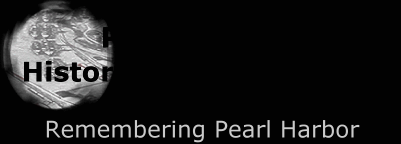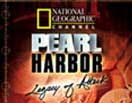Few events in the history of the United States have generated as much controversy
as the attack on Pearl Harbor.
Rumors abounded during the war, and the release of the Congressional Investigation Report on July 26, 1946, while containing information that would scotch most of them, did not end the speculations. Part of the problem with the Pearl Harbor Attack Investigation Report (PHA for short) was that it was in 40 parts bound in about 23 volumes. Extracting the answers to the bizarre stories that ran rampant was a daunting task for even the most serious researcher.
Today, however, with the aid of computer searching, we can locate information about events and people that have been buried in stacks and university attics for decades. Of course, no one will be able to convince the die-hard Roosevelt-haters that he didn't arrange, or at least allow, the attack, but for those of us who simply want the answers to questions such as "Why didn't the Opana Point radar-contact report reach Adm. Kimmel?", the testimonies of the people involved will illuminate the situation in a most satifactory manner.
Each link below will take you to a document which explains why a particular myth is either wholly false or a distortion of the facts. We will be adding more myths as time permits, but do
write us
with your favorite if you don't see it on the list. We'll check the record and provide what documents are available on that topic in the timeliest manner possible.
First, here is a set of chronologies with the original documents linked to the dates of important events.
A Chronological Collection of Documents Relating to the U.S. Entry Into WWII.
With a clearer understanding of what happened when most myths simply fall apart.
MYTH : The US carriers were hustled out of port just before the attack, to "save" them for a war that FDR already knew would be dominated by the flattop.
FACT: The two carriers then operating from Pearl Harbor, Enterprise and Lexington, were on missions to deliver additional fighters to Wake and Midway.
See the document.
These assignments sent the carriers west, toward Japan and the IJN, widely separated and lightly escorted.
On Dec. 7th, Enterprise was about 200 miles west of Pearl and inbound to Pearl. Lexington was 400 miles to the west and heading for Midway. See Admiral Kimmel's report on these missions.
"OK, but they were still out of port!" Yes, but Enterprise was doing her best to get back into Pearl. Her first ETA was Saturday evening, but a storm delayed her. The next time set was 7 AM, 55 minutes before the attack started, but that proved too optimistic as well. She was, however, close enough to Pearl to send her aircraft ahead to land at Ford Island, and some of them were shot down by "friendly fire." See the first document in this section.
What really crushes the "carriers hustled out of port" myth is the fact that Enterprise was scheduled to be in port on Dec. 6th and 7th, as shown in the Employment Schedule promulgated in August, '41. No orders were ever recieved to change this. The mission to Wake was planned to coincide with the original schedule so that it would not be known that the island had recieved additional air support. The trip was kept secret, even the loading of the planes had a "cover story".
MYTH : Pearl Harbor was not sent an urgent message on the morning of Dec. 7th so as to prevent the fleet from being alerted. Variations include using commercial telegraph instead of military radio to transmit the message so as to delay arrival of the message.
FACT: Atmospheric conditions prevented radio communications between D.C. and Pearl Harbor. The choice of commercial telegram, while possibly not the best means of communication, was chosen for reasons given to the investigations.
See the Congressional evaluation.
The Army Board was rather more critical of the choices made.
It is important to note that the message DID arrive in Hawaii at 7:33 am T.H. Time, and was delayed due to the attack. Why send it at all if the conspirators didn't want to tip their hand?
MYTH : The U.S.N. thought that the harbor at Pearl Harbor was too shallow to allow a torpedo attack.
FACT: The document shown is a message from the Chief Of Naval Operations which states that no harbor is to be considered safe from torpedo attack. The consideration at Pearl Harbor, however, was that the fleet should be ready to sortie on short notice and removing anti-torpedo netting would slow the units' exit from the harbor.
See the document.
MYTH : The "Fourteen-part message", which the Japanese ambassador was supposed to deliver to the U.S. Secretary of State 1/2 hour before the attack on Pearl Harbor began, was a declaration of war, or at least a breaking off of diplomatic relations which would have signaled war.
FACT: The message is not a declaration of war, and did not even break off diplomatic relations. Beyond a recapitulation of Japanese greivances against the U.S., and the United Kingdom and the Netherlands, there doesn't seem to be any real point to the message at all.
See the document.
So when did the Japanese government prepare the declaration of war? Was it just not delivered on time? The record from Japanese sources shows that the meeting called to write it didn't convene until 12:44 pm, Dec. 7th, Pearl Harbor time.
See the document.
The Japanese delivered a two-line note to Ambassador Grew on the afternoon of the Dec. 8th, Tokyo Time (late morning, Dec. 7th, T.H.Time.) The Imperial Rescript telling the Japanese people they were at war was heard in the U.S. at 4 pm, Dec. 7th, D.C. Time.
MYTH : The Captain of USS WARD, on anti-submarine patrol outside the
entrance to Pearl Harbor, sent a message that he had sunk a submarine over an hour before the aerial attack began.
FACT: See the file for WARD's actual report to the ComFOURTEENTH message center. Captain Outerbridge reports attacking a sub, but not sinking it. (As time permits we will follow the message through the system to Adm. Kimmel, who will not be playing golf while this is all going on.)
[See the document.]
Reproduction
of the Bishop's Point Radio Log
which shows WARD's reports to Com 14th. The other signifcant message is at 1810Z, when a coded request for confirmation came to WARD. Decoding the message and encoding a reply took time and by the time it was ready, bombs were already falling.
MYTH : The Opana Point Radar reported the Japanese attack 1 hour before the planes arrived over the harbor, but Adm. Kimmel refused to do anything about it.
FACT: Pvts. Eliot and Lockard were manning the radar at Opana Point. They noticed a large blip on the scope and call in to the as-yet not fully functional Fighter Information Center. Pvt. McDonald took the call and located the sole officer at the Center and asked him to call the operators back. Lt. Kermit Tyler, having ending his first tour of training at the newly established Fighter Control Center, received the report and, thinking it was a flight of B-17s due in from the mainland, told the operators to "forget it." The report went no higher than that. Interestingly enough, the new radars tracked the planes coming and going, but the Army did not tell the Navy about this pointer to the Japanese carriers until the 8th, a fact which quite possibly saved our carriers.
There are only a few people who were actually involved in either the sighting or the establishment of the Figher Information Center. Privates Lockard and Elliot were at Opana Point, Pvt. McDonald and Lt. Tyler were in the FIC. Other "interested parties" were Col. Bergquist, who with Col. Tindal established the FIC, and Cmdr. Taylor, USN, who was in Hawaii to teach the Navy how to use radar (and was on "loan" to the Army for the same purpose on Dec. 7th.) All of their testimonies are now vailable.
See the documents.
This is just one of the more bizarre things to be found in the PHA. Notice that the ambassadors are suggesting a meeting of senior people from both sides at some midway point, such as Hawaii, on Dec. 6th! This gives the reader a better understanding of how much the Japanese diplomatic services in the US, and a good idea of how much information was broadcast on the Purple code.
See the document.


![[IMAGE]](phattackedbannersmall.gif)

